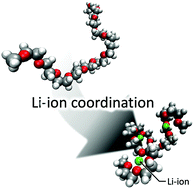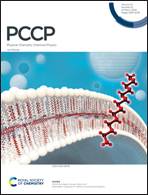Lithium-ion coordination-induced conformational change of PEG chains in ionic-liquid-based electrolytes†
Abstract
We report the structure of poly(ethylene glycol) (PEG) in a imidazolium-based ionic liquid (IL) electrolyte containing lithium bis(trifluoromethanesulfonyl)amide (LiTFSA) salt, as determined using Raman spectroscopy, high-energy X-ray total scattering (HEXTS), and molecular dynamics (MD) simulations. The Raman spectral study indicated that the TFSA anions bound to Li ions are desolvated when PEG is added to the LiTFSA/IL solution to form stable Li+–PEG complexes. Via quantitative analysis of the obtained Raman spectra, the desolvation number of the TFSA [nd, per one oxygen atom of the ethylene glycol unit (Opeg)] was determined to be ∼0.4, irrespective of the shape (star or linear) and molecular weight of the polymer. On the basis of radial distribution functions obtained from the HEXTS experiments and MD simulations, we demonstrated that the Li+–PEG complexation induces a conformational change of the PEG chain from gauche/anti-conformers to a syn conformer. This Li+-coordination-induced conformation resulted in a decrease in the radius of gyration (Rg) of the PEG chain, implying a folding behavior of polymer chains through multiple Opeg⋯Li+⋯Opeg interactions.



 Please wait while we load your content...
Please wait while we load your content...